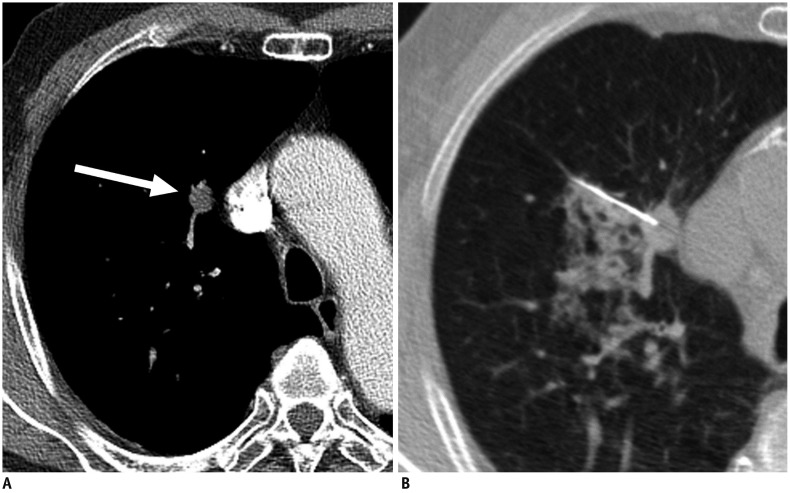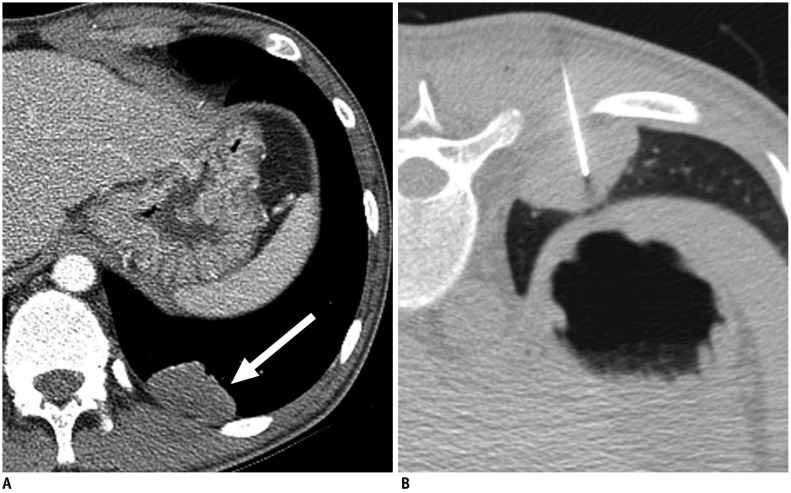Korean J Radiol.
2019 Aug;20(8):1300-1310. 10.3348/kjr.2019.0189.
Diagnostic Accuracy of Percutaneous Transthoracic Needle Lung Biopsies: A Multicenter Study
- Affiliations
-
- 1Department of Radiology, Seoul National University Bundang Hospital, Seongnam, Korea.
- 2Department of Radiology, National Cancer Center, Goyang, Korea.
- 3Department of Radiology, Severance Hospital, Yonsei University College of Medicine, Seoul, Korea.
- 4Research Institute of Radiological Science, Severance Hospital, Yonsei University College of Medicine, Seoul, Korea.
- 5Department of Radiology, Seoul St. Mary's Hospital, College of Medicine, The Catholic University of Korea, Seoul, Korea.
- 6Department of Radiology, Inje University Sanggye Paik Hospital, Seoul, Korea.
- 7Department of Radiology, Korea University Ansan Hospital, Korea University College of Medicine, Ansan, Korea.
- 8Department of Radiology, Kyung Hee University Hospital at Gangdong, College of Medicine, Kyung Hee University, Seoul, Korea.
- 9Department of Radiology, Seoul National University College of Medicine, Seoul, Korea. cmpark.morphius@gmail.com
- 10Department of Statistics, Inha University, Incheon, Korea.
- 11Institute of Radiation Medicine, Seoul National University Medical Research Center, Seoul, Korea.
- KMID: 2453080
- DOI: http://doi.org/10.3348/kjr.2019.0189
Abstract
OBJECTIVE
To measure the diagnostic accuracy of percutaneous transthoracic needle lung biopsies (PTNBs) on the basis of the intention-to-diagnose principle and identify risk factors for diagnostic failure of PTNBs in a multi-institutional setting.
MATERIALS AND METHODS
A total of 9384 initial PTNBs performed in 9239 patients (mean patient age, 65 years [range, 20-99 years]) from January 2010 to December 2014 were included. The accuracy, sensitivity, specificity, positive predictive value (PPV), and negative predictive value (NPV) of PTNBs for diagnosis of malignancy were measured. The proportion of diagnostic failures was measured, and their risk factors were identified.
RESULTS
The overall accuracy, sensitivity, specificity, PPV, and NPV were 91.1% (95% confidence interval [CI], 90.6-91.7%), 92.5% (95% CI, 91.9-93.1%), 86.5% (95% CI, 85.0-87.9%), 99.2% (95% CI, 99.0-99.4%), and 84.3% (95% CI, 82.7-85.8%), respectively. The proportion of diagnostic failures was 8.9% (831 of 9384; 95% CI, 8.3-9.4%). The independent risk factors for diagnostic failures were lesions ≤ 1 cm in size (adjusted odds ratio [AOR], 1.86; 95% CI, 1.23-2.81), lesion size 1.1-2 cm (1.75; 1.45-2.11), subsolid lesions (1.81; 1.32-2.49), use of fine needle aspiration only (2.43; 1.80-3.28), final diagnosis of benign lesions (2.18; 1.84-2.58), and final diagnosis of lymphomas (10.66; 6.21-18.30). Use of cone-beam CT (AOR, 0.31; 95% CI, 0.13-0.75) and conventional CT-guidance (0.55; 0.32-0.94) reduced diagnostic failures.
CONCLUSION
The accuracy of PTNB for diagnosis of malignancy was fairly high in our large-scale multi-institutional cohort. The identified risk factors for diagnostic failure may help reduce diagnostic failure and interpret the biopsy results.
MeSH Terms
Figure
Reference
-
1. Staroselsky AN, Schwarz Y, Man A, Marmur S, Greif J. Additional information from percutaneous cutting needle biopsy following fine-needle aspiration in the diagnosis of chest lesions. Chest. 1998; 113:1522–1525. PMID: 9631788.
Article2. Ohno Y, Hatabu H, Takenaka D, Higashino T, Watanabe H, Ohbayashi C, et al. CT-guided transthoracic needle aspiration biopsy of small (< or = 20 mm) solitary pulmonary nodules. AJR Am J Roentgenol. 2003; 180:1665–1669. PMID: 12760939.3. Hiraki T, Mimura H, Gobara H, Iguchi T, Fujiwara H, Sakurai J, et al. CT fluoroscopy-guided biopsy of 1,000 pulmonary lesions performed with 20-gauge coaxial cutting needles: diagnostic yield and risk factors for diagnostic failure. Chest. 2009; 136:1612–1617. PMID: 19429718.4. Choi SH, Chae EJ, Kim JE, Kim EY, Oh SY, Hwang HJ, et al. Percutaneous CT-guided aspiration and core biopsy of pulmonary nodules smaller than 1 cm: analysis of outcomes of 305 procedures from a tertiary referral center. AJR Am J Roentgenol. 2013; 201:964–970. PMID: 24147465.
Article5. Choo JY, Park CM, Lee NK, Lee SM, Lee HJ, Goo JM. Percutaneous transthoracic needle biopsy of small (≤ 1 cm) lung nodules under C-arm cone-beam CT virtual navigation guidance. Eur Radiol. 2013; 23:712–719. PMID: 22976917.6. Lee SM, Park CM, Lee KH, Bahn YE, Kim JI, Goo JM. C-arm cone-beam CT-guided percutaneous transthoracic needle biopsy of lung nodules: clinical experience in 1108 patients. Radiology. 2014; 271:291–300. PMID: 24475839.
Article7. Fontaine-Delaruelle C, Souquet PJ, Gamondes D, Pradat E, De Leusse A, Ferretti GR, et al. Negative predictive value of transthoracic core-needle biopsy: a multicenter study. Chest. 2015; 148:472–480. PMID: 25569025.8. Takeshita J, Masago K, Kato R, Hata A, Kaji R, Fujita S, et al. CT-guided fine-needle aspiration and core needle biopsies of pulmonary lesions: a single-center experience with 750 biopsies in Japan. AJR Am J Roentgenol. 2015; 204:29–34. PMID: 25539234.
Article9. Schuetz GM, Schlattmann P, Dewey M. Use of 3x2 tables with an intention to diagnose approach to assess clinical performance of diagnostic tests: meta-analytical evaluation of coronary CT angiography studies. BMJ. 2012; 345:e6717. PMID: 23097549.
Article10. Kim JI, Park CM, Kim H, Lee JH, Goo JM. Non-specific benign pathological results on transthoracic core-needle biopsy: how to differentiate false-negatives? Eur Radiol. 2017; 27:3888–3895. PMID: 28188426.
Article11. Lee KH, Lim KY, Suh YJ, Hur J, Han DH, Kang MJ, et al. Nondiagnostic percutaneous transthoracic needle biopsy of lung lesions: a multicenter study of malignancy risk. Radiology. 2019; 290:814–823. PMID: 30561276.12. Yoon SH, Park CM, Lee KH, Lim KY, Suh YJ, Im DJ, et al. Analysis of complications of percutaneous transthoracic needle biopsy using CT-guidance modalities in a multicenter cohort of 10568 biopsies. Korean J Radiol. 2019; 20:323–331. PMID: 30672172.
Article13. Lin HH, Ezzati M, Chang HY, Murray M. Association between tobacco smoking and active tuberculosis in Taiwan: prospective cohort study. Am J Respir Crit Care Med. 2009; 180:475–480. PMID: 19542475.14. Schreiber G, McCrory DC. Performance characteristics of different modalities for diagnosis of suspected lung cancer: summary of published evidence. Chest. 2003; 123(1 Suppl):115S–128S. PMID: 12527571.15. Yeow KM, Tsay PK, Cheung YC, Lui KW, Pan KT, Chou AS. Factors affecting diagnostic accuracy of CT-guided coaxial cutting needle lung biopsy: retrospective analysis of 631 procedures. J Vasc Interv Radiol. 2003; 14:581–588. PMID: 12761311.
Article16. Henschke CI, Yankelevitz DF, Mirtcheva R, McGuinness G, McCauley D, Miettinen OS. ELCAP Group. CT screening for lung cancer: frequency and significance of part-solid and nonsolid nodules. AJR Am J Roentgenol. 2002; 178:1053–1057. PMID: 11959700.17. Lee SM, Park CM, Song YS, Kim H, Kim YT, Park YS, et al. CT assessment-based direct surgical resection of part-solid nodules with solid component larger than 5 mm without preoperative biopsy: experience at a single tertiary hospital. Eur Radiol. 2017; 27:5119–5126. PMID: 28656460.18. Yao X, Gomes MM, Tsao MS, Allen CJ, Geddie W, Sekhon H. Fine-needle aspiration biopsy versus core-needle biopsy in diagnosing lung cancer: a systematic review. Curr Oncol. 2012; 19:e16–e27. PMID: 22328844.19. Kim H, Chae KJ, Yoon SH, Kim M, Keam B, Kim TM, et al. Repeat biopsy of patients with acquired resistance to EGFR TKIs: implications of biopsy-related factors on T790M mutation detection. Eur Radiol. 2018; 28:861–868. PMID: 28786010.
Article20. Yoon HJ, Lee HY, Lee KS, Choi YL, Ahn MJ, Park K, et al. Repeat biopsy for mutational analysis of non-small cell lung cancers resistant to previous chemotherapy: adequacy and complications. Radiology. 2012; 265:939–948. PMID: 22929335.
Article
- Full Text Links
- Actions
-
Cited
- CITED
-
- Close
- Share
- Similar articles
-
- Implantation Metastasis After Percutaneous Transthoracic Fine Needle Biopsy of Lung Cancer: A Case Report
- Transthoracic Needle Biopsy: How to Maximize Diagnostic Accuracy and Minimize Complications
- Transthoracic Needle Biopsy of Thoracic Lesions
- Transthoracic Fine Needle Aspiration Biopsy: Diagnostic Rate and Complications in 1000 Cases
- CT-Guided Percutaneous Automated Gun Biopsy of Pulmonary Lesions: Complications and Diagnostic Accuracy



